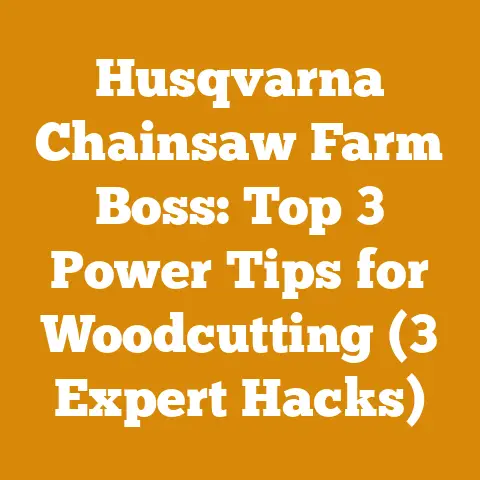Maple Tree Multiple Trunks (5 Key Safety Checks for Woodcutting)
I’ve always admired the resilience of maple trees, especially those with multiple trunks. They stand as a testament to nature’s ability to adapt and thrive. Their unusual structure demands a heightened awareness of safety. Over the years, I’ve learned firsthand the critical safety checks needed when felling a multi-trunk maple. This guide shares my experiences and insights to help you safely handle these magnificent, yet potentially dangerous, trees.
Maple Tree Multiple Trunks: 5 Key Safety Checks for Woodcutting
Cutting down any tree demands respect and caution, but a maple with multiple trunks amplifies the risk. It’s not just about pointing a chainsaw and hoping for the best. It’s about understanding the tree’s structure, identifying potential hazards, and implementing a meticulous plan. I’ve seen too many close calls in my time, and I’m here to help you avoid them. These five key safety checks are non-negotiable in my book. They form the foundation of a safe and successful felling operation.
Visual Inspection
Begin with a visual sweep. Look for:
- Dead or decaying wood: Multiple trunks often mean multiple points of entry for rot. Pay close attention to the bases where the trunks join. Use a tool like an ice pick or screwdriver to probe for soft spots. This is especially crucial as these weak points can cause unpredictable breaks during the cut.
- Cracks or splits: These are stress indicators. They tell you where the tree is already under pressure and where it might fail. Notice the direction and depth of any cracks.
- Lean: Does the tree have a natural lean? This will influence your felling direction and require careful planning. I once misjudged a slight lean and nearly had a trunk fall back on me.
- Overhead hazards: Look up! Are there any dead branches (widow makers) that could fall during the cutting process? These are silent dangers.
- Interlocking branches: How are the branches of the multiple trunks intertwined? This will affect how the tree falls and could create binding issues.
- Insect or fungal damage: Signs of infestation or fungal growth weaken the wood and make it unpredictable.
Root System Examination
The root system is the foundation of the tree. Its condition directly impacts stability.
- Examine the base: Look for exposed roots, soil heaving, or signs of root rot. These indicate a compromised root system. I’ve seen trees with seemingly healthy trunks topple unexpectedly because of hidden root problems.
- Check for root damage: Construction, erosion, or animal activity can damage roots and weaken the tree.
- Soil conditions: Is the soil saturated or dry? Saturated soil reduces root support.
Environmental Factors
Consider the weather. Wind, rain, and snow significantly increase the risk of felling.
- Wind speed and direction: High winds can push the tree off course. I always postpone felling in winds exceeding 20 mph.
- Rain or snow: Wet or icy conditions make footing treacherous and increase the weight of the tree.
- Temperature: Freezing temperatures can make wood brittle and more prone to splintering.
Data and Measurements:
- Tree Height: Use a clinometer or estimate the height using a stick method. Accurate height is crucial for planning the felling zone.
- Trunk Diameters: Measure the diameter of each trunk at breast height (DBH). This helps estimate the tree’s weight and choose the appropriate chainsaw.
- Lean Angle: Use a protractor or inclinometer to measure the lean angle. This is essential for calculating the necessary back cut.
- Felling Zone Radius: Calculate the felling zone radius as 1.5 to 2 times the tree’s height. Ensure this area is clear of people and obstacles.
Case Study:
I once assessed a multi-trunk maple that appeared healthy. However, a closer inspection revealed extensive root rot at the base of one trunk. The tree had a slight lean towards a neighbor’s property. Based on the assessment, I recommended removing the rotted trunk first, using a crane to control the fall, and then felling the remaining trunks in a controlled manner. This approach minimized the risk of damage to the neighbor’s property and ensured the safety of the crew.
2. Develop a Detailed Felling Plan
A well-thought-out felling plan is your roadmap to success. It’s not just about where you want the tree to fall. It’s about anticipating problems and having solutions ready. I always say, “Hope for the best, but plan for the worst.”
Determine Felling Direction
This is arguably the most critical decision. Consider the following:
- Natural lean: Use the tree’s natural lean to your advantage.
- Wind direction: Avoid felling into the wind.
- Obstacles: Identify any obstacles in the felling zone (buildings, power lines, fences).
- Escape routes: Plan two clear escape routes at a 45-degree angle away from the felling direction. I always clear these routes before making any cuts.
Choose Cutting Techniques
Multiple trunks require adapting your cutting techniques.
- Notch cut: The notch cut determines the felling direction. For multi-trunk trees, you might need to create multiple notches, one for each trunk, or a single, wider notch that encompasses all trunks. The angle should be 45-70 degrees.
- Back cut: The back cut is made opposite the notch cut. Leave a hinge of uncut wood to control the fall. The hinge should be about 10% of the trunk diameter.
- Holding wood: In some cases, you might need to leave holding wood to prevent the tree from splitting prematurely.
- Boring cut: This technique involves plunging the chainsaw into the trunk to relieve pressure or create a hinge point. Be extremely cautious when using this technique. Kickback is a significant risk.
Select the Right Tools
Using the right tools for the job is essential for safety and efficiency.
- Chainsaw: Choose a chainsaw with sufficient power and bar length for the trunk diameters. I recommend a professional-grade saw with a chain brake and anti-vibration features.
- Wedges: Use felling wedges to help direct the fall and prevent the saw from pinching. I prefer plastic wedges over metal ones because they are less likely to damage the chain if you accidentally hit them.
- Felling lever: A felling lever provides extra leverage to push the tree over.
- Measuring tape: Accurate measurements are crucial for precise cuts.
- Chainsaw sharpener: A sharp chain is a safe chain. Dull chains require more force and increase the risk of kickback.
- Personal Protective Equipment (PPE): Never operate a chainsaw without proper PPE. This includes a helmet, eye protection, hearing protection, chainsaw chaps, gloves, and sturdy boots.
Communication and Teamwork
If you’re working with a team, clear communication is essential.
- Establish hand signals: Use hand signals to communicate during the felling process.
- Assign roles: Clearly define each team member’s responsibilities.
- Hold a pre-felling briefing: Discuss the felling plan and potential hazards with the team.
Data and Measurements:
- Notch Depth: The notch depth should be about 20% of the trunk diameter.
- Hinge Width: The hinge width should be about 10% of the trunk diameter.
- Wedge Size: Choose wedges that are appropriate for the trunk diameter.
- Chainsaw Bar Length: Select a chainsaw with a bar length that is at least 2 inches longer than the trunk diameter.
Case Study:
I once worked on a multi-trunk maple that was leaning heavily towards a power line. The initial plan was to fell the tree in the opposite direction. However, after closer inspection, I realized that the root system was compromised on that side. Felling in the opposite direction would have been too risky. I revised the plan to use a crane to support the tree while making the cuts. This allowed us to safely remove the tree without damaging the power line.
Takeaway: A detailed felling plan minimizes risks and maximizes safety. Don’t rush this step. Take the time to assess the situation, plan your approach, and gather the necessary tools.
3. Perform Thorough Chainsaw Maintenance and Safety Checks
A well-maintained chainsaw is a safe chainsaw. Neglecting maintenance is like playing Russian roulette. I’ve seen too many accidents caused by faulty equipment.
Pre-Operation Checks
Before each use, perform the following checks:
- Chain tension: The chain should be snug but not too tight. You should be able to pull the chain away from the bar slightly.
- Chain sharpness: A sharp chain cuts smoothly and efficiently. Dull chains require more force and increase the risk of kickback.
- Bar condition: Check the bar for wear, damage, or burrs.
- Fuel and oil levels: Ensure that the fuel and oil tanks are full.
- Chain brake: Test the chain brake to ensure it is functioning properly.
- Throttle trigger and interlock: Check that the throttle trigger and interlock are working correctly.
- Anti-vibration system: Inspect the anti-vibration system for damage.
- Air filter: Clean the air filter regularly to maintain engine performance.
- Spark plug: Check the spark plug for fouling.
Regular Maintenance
Regular maintenance extends the life of your chainsaw and ensures safe operation.
- Sharpen the chain: Sharpen the chain regularly using a file or a chain grinder.
- Clean the bar: Clean the bar and groove regularly to remove debris.
- Lubricate the bar: Lubricate the bar regularly with chainsaw bar oil.
- Replace the air filter: Replace the air filter as needed.
- Replace the spark plug: Replace the spark plug as needed.
- Inspect the chain sprocket: Inspect the chain sprocket for wear.
- Check the clutch: Check the clutch for wear.
- Tighten all nuts and bolts: Ensure that all nuts and bolts are tight.
Safety Features
Understand and utilize the safety features of your chainsaw.
- Chain brake: The chain brake stops the chain immediately in case of kickback.
- Chain catcher: The chain catcher prevents the chain from flying back towards the operator if it breaks.
- Throttle interlock: The throttle interlock prevents accidental throttle engagement.
- Anti-vibration system: The anti-vibration system reduces operator fatigue.
Data and Measurements:
- Chain Tension: The chain should have about 1/8 inch of slack.
- Bar Oil Flow Rate: The bar oil flow rate should be sufficient to lubricate the chain and bar.
- Air Filter Cleaning Frequency: Clean the air filter every 25 hours of operation or more frequently in dusty conditions.
- Spark Plug Replacement Frequency: Replace the spark plug every 100 hours of operation.
Case Study:
I once experienced a near-miss when the chain on my chainsaw broke during a felling operation. Fortunately, the chain catcher prevented the chain from hitting me. The incident highlighted the importance of regularly inspecting and maintaining the chain. I now replace my chains more frequently and pay closer attention to signs of wear.
Takeaway: Chainsaw maintenance is not optional. It’s a critical safety requirement. Regularly inspect your saw, perform necessary maintenance, and understand its safety features. Your life may depend on it.
4. Implement Safe Cutting Techniques for Multiple Trunks
Cutting a multi-trunk maple requires adapting standard felling techniques. The interconnected structure presents unique challenges. Precision and control are paramount.
Addressing Tension and Compression
Understanding tension and compression is crucial for safe cutting.
- Tension: Tension is the force that pulls wood fibers apart.
- Compression: Compression is the force that pushes wood fibers together.
- Identify tension and compression zones: Before making any cuts, identify the areas of tension and compression in each trunk.
- Relieve tension: Make cuts to relieve tension before cutting through compression zones. This prevents the saw from pinching and reduces the risk of splitting.
Step-by-Step Cutting Process
I’ve developed a specific process for felling multi-trunk maples.
- Clear the area: Remove any obstacles from the felling zone and escape routes.
- Establish a stable stance: Ensure you have a firm footing before starting the saw.
- Make the notch cut: Create a notch cut in each trunk, ensuring that the notches align with the desired felling direction. The notch angle should be between 45 and 70 degrees.
- Make the back cut: Make the back cut opposite the notch cut, leaving a hinge of uncut wood to control the fall. The hinge should be about 10% of the trunk diameter.
- Use wedges: Insert felling wedges into the back cut to help direct the fall and prevent the saw from pinching.
- Monitor the tree: Watch the tree closely for any signs of movement.
- Retreat safely: As the tree begins to fall, retreat quickly along your pre-planned escape routes.
Special Considerations for Multiple Trunks
- Interlocking branches: If the branches are heavily intertwined, you may need to remove some branches before felling the tree.
- Uneven trunk sizes: If the trunks are of different sizes, start by felling the smaller trunks first.
- Weak unions: If the trunks are weakly connected, use extra caution to prevent them from splitting apart prematurely.
- Barber Chair: Barber chairing is when the tree splits upward during the back cut, posing a significant hazard. To prevent this, use a boring cut to relieve tension before completing the back cut.
Data and Measurements:
- Notch Angle: 45-70 degrees.
- Hinge Thickness: 10% of trunk diameter.
- Wedge Placement: Insert wedges as deep as possible into the back cut.
- Escape Route Angle: 45 degrees away from the felling direction.
Case Study:
I once felled a multi-trunk maple where one trunk was significantly larger than the others. I started by felling the smaller trunks first, using wedges to control their fall. This reduced the overall weight of the tree and made it easier to fell the larger trunk safely. I also used a boring cut to relieve tension and prevent barber chairing.
Takeaway: Safe cutting techniques are essential for managing the unique challenges of multi-trunk trees. Understand tension and compression, follow a step-by-step process, and adapt your techniques to the specific situation.
5. Emphasize Personal Protective Equipment (PPE) and Emergency Preparedness
PPE is your last line of defense. It won’t prevent accidents, but it can significantly reduce the severity of injuries. I never start a job without ensuring everyone is properly equipped. And emergency preparedness is just as crucial. Knowing what to do in case of an accident can save a life.
Essential PPE
- Helmet: A helmet protects your head from falling branches and debris. Choose a helmet that meets ANSI Z89.1 standards.
- Eye protection: Safety glasses or a face shield protect your eyes from flying chips and dust.
- Hearing protection: Earplugs or earmuffs protect your hearing from the loud noise of the chainsaw. I prefer earmuffs because they are more comfortable and provide better protection.
- Chainsaw chaps: Chainsaw chaps protect your legs from chainsaw cuts. Choose chaps that meet ASTM F1897 standards.
- Gloves: Gloves protect your hands from cuts, abrasions, and vibration. I prefer leather gloves with reinforced palms.
- Sturdy boots: Sturdy boots with good ankle support protect your feet and ankles from injury. Choose boots that meet ASTM F2413 standards.
Emergency Preparedness
- First-aid kit: Keep a well-stocked first-aid kit on site.
- Communication: Carry a cell phone or two-way radio to communicate with others in case of an emergency.
- Emergency plan: Develop an emergency plan that outlines the steps to take in case of an accident.
- Training: Get certified in first aid and CPR.
Safe Work Practices
- Avoid fatigue: Take frequent breaks to avoid fatigue. Fatigue increases the risk of accidents.
- Stay hydrated: Drink plenty of water to stay hydrated.
- Work in pairs: Never work alone when felling trees.
- Maintain a safe distance: Keep a safe distance from the chainsaw when it is in operation.
- Be aware of your surroundings: Pay attention to your surroundings and be aware of potential hazards.
- Never rush: Take your time and work carefully. Rushing increases the risk of accidents.
- Stop if you are unsure: If you are unsure about something, stop and ask for help.
Data and Measurements:
- Helmet Impact Resistance: Helmets should meet ANSI Z89.1 standards, which require them to withstand a certain level of impact.
- Chainsaw Chap Protection: Chainsaw chaps should meet ASTM F1897 standards, which specify the level of protection they provide against chainsaw cuts.
- First-Aid Kit Contents: A well-stocked first-aid kit should include bandages, antiseptic wipes, pain relievers, and other essential supplies.
- Communication Range: Two-way radios should have a range of at least 1 mile.
Case Study:
I once witnessed a fellow logger suffer a chainsaw cut to the leg. Fortunately, he was wearing chainsaw chaps, which significantly reduced the severity of the injury. The incident reinforced the importance of wearing proper PPE.
Takeaway: PPE and emergency preparedness are non-negotiable. Always wear proper PPE and have a plan in place for dealing with emergencies. Your safety and the safety of your team depend on it.
Cutting down a multi-trunk maple tree is a complex and potentially dangerous task. By following these five key safety checks, you can significantly reduce the risk of accidents and ensure a safe and successful felling operation. Remember, safety is not just a set of rules. It’s a mindset. Always be aware of your surroundings, take your time, and never hesitate to ask for help. I hope this guide has been helpful. Stay safe out there.






